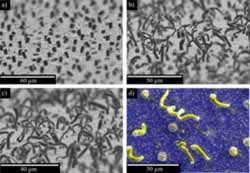Gold squeezed into micro-Velcro

SEM micrographs showing a variety of Au microwire morphologies depending on the overall Au content: a) Short and straight wires appear at 42 at.% Au. b) With increasing Au content to 44 at.% the wires become longer and start bending. c) They achieve a maximum length and a hook-like shape at 48 at.% Au. d) False-color picture generated from elemental composition maps for 46 at.% Au (Au: yellow, W: blue).<br>
Velcro consists of one surface with loops, and another with hooks that latch onto the loops, joining opposing surfaces strongly. A miniaturised version of Velcro could be used in micro- and nanotechnology, but to form the surfaces, microwires are needed with properties that provide strength and durability.
Several different approaches have been used to construct ‘micro-Velcro’, but the most promising are those that use self-assembling or self-organising techniques, where microwires are ‘squeezed’ from a composite material by compression. Researchers at Ruhr University Bochum, Germany, have used this technique to produce gold microwires that have suitable properties for micro-Velcro.
The scientists created thin films of composite materials containing gold and tungsten metal. These were then heated to very high temperatures, causing the tungsten to react with oxygen and form tungsten oxide. This increased the volume of the tungsten and caused compression within the composite, ‘squeezing’ the softer gold out as ‘whiskers’.
Different ratios of gold to tungsten were tried in the original composite, and these were heated to different temperatures and for different times to find the optimal conditions. The best result produced gold microwires approximately 35 micrometres long – similar to the width of a human hair – and 2 micrometres in diameter.
The resulting gold microwires have larger diameters than indium metal microwires that had previously been made using a similar technique, making them more suitable for micro Velcro. The results demonstrate that this new approach is a feasible one for producing the microwires that could be used to make micro-Velcro.
This research was published in the journal, Science and Technology of Advanced Materials.
Media contact:
Mikiko Tanifuji
National Institute for Materials Science, Tsukuba, Japan
Email: stam_office@nims.go.jp
Tel. +81-(0)29-859-2494
Journal information
Sven Hamann et al 2013 Sci. Technol. Adv. Mater. 14 015003 doi:10.1088/1468-6996/14/1/015003
Media Contact
All latest news from the category: Materials Sciences
Materials management deals with the research, development, manufacturing and processing of raw and industrial materials. Key aspects here are biological and medical issues, which play an increasingly important role in this field.
innovations-report offers in-depth articles related to the development and application of materials and the structure and properties of new materials.
Newest articles

High-energy-density aqueous battery based on halogen multi-electron transfer
Traditional non-aqueous lithium-ion batteries have a high energy density, but their safety is compromised due to the flammable organic electrolytes they utilize. Aqueous batteries use water as the solvent for…

First-ever combined heart pump and pig kidney transplant
…gives new hope to patient with terminal illness. Surgeons at NYU Langone Health performed the first-ever combined mechanical heart pump and gene-edited pig kidney transplant surgery in a 54-year-old woman…

Biophysics: Testing how well biomarkers work
LMU researchers have developed a method to determine how reliably target proteins can be labeled using super-resolution fluorescence microscopy. Modern microscopy techniques make it possible to examine the inner workings…





















